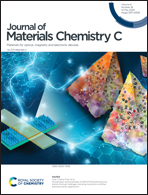Twisted acceptors in the design of deep-blue TADF emitters: crucial role of excited-state relaxation in the photophysics of methyl-substituted s-triphenyltriazine derivatives†
Abstract
Among the most popular approaches recently applied to design blue thermally activated delayed fluorescence (TADF) emitters, those utilizing alkyl-substituted distorted acceptor or donor fragments seem to have very high potential and wide applicability to organic materials. Here, we have taken a detailed systematic look, for the first time, on how such a distortion affects singlet/triplet states, (reverse) inter-system crossing rates, (non)radiative deactivations, and intermolecular interactions in donor–acceptor TADF emitters based on six new emitters with the non-planar s-triaryltriazine acceptor as examples. Our results evidenced that despite being a frequently used approach, the emissive features of the twisted molecules cannot be explained based on their crystal or ground-state geometries due to the excited-state structural relaxation and planarization. Likewise, the determination of ΔEST from the fluorescence/phosphorescence spectra was found to be unreliable due to the strong influence of temperature and viscosity on the excited-state structural relaxation. Moreover, the discussed approach enabled deep-blue TADF only in highly viscous media, inhibiting the excited-state planarization. Consequently, we designed an efficient deep-blue TADF emitter with the highest rISC rate among the investigated compounds in the condensed phase. Its highly twisted structure provided high excited-state energies with small energy gaps between them and inhibited nonradiative decay. This enabled the deep-blue TADF emitter to achieve the high photoluminescence quantum yields values of 77% and 60% with the CIE coordinates (0.16, 0.16) and (0.15, 0.06) in PMMA films and crystals, respectively, and 17.6% EQEmax in a blue OLED device.



 Please wait while we load your content...
Please wait while we load your content...